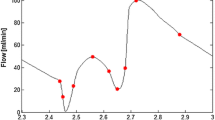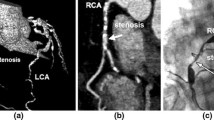Abstract
The design of coronary stents has evolved significantly over the past two decades. However, they still face the problem of in-stent restenosis, formation of neointima within 12 months of the implant. The biological response after stent implantation depends on various factors including the stent geometry which alters the hemodynamics. This study takes five different coronary stent designs, used in clinical practice, and explores the hemodynamic differences arising due to the difference in their design. Of particular interest is the design of the segments (connectors) that connect two struts. Pulsatile blood flow analysis is performed for each stent, using 3-D computational fluid dynamics (CFD), and various flow features viz. recirculation zones, velocity profiles, wall shear stress (WSS) patterns, and oscillatory shear indices are extracted for comparison. Vessel wall regions with abnormal flow features, particularly low, reverse, and oscillating WSS, are usually more susceptible to restenosis. Unlike previous studies, which have tried to study the effect of design parameters such as strut thickness and strut spacing on hemodynamics, this work investigates the differences in the flow arising purely due to differences in stent-shape, other parameters being similar. Two factors, the length of the connectors in the cross-flow direction and their alignment with the main flow, are found to affect the hemodynamic performance. This study also formulates a design index (varying from 18.81% to 24.91% for stents used in this study) that quantifies the flow features that could affect restenosis rates and which, in future, could be used for optimization studies.
















Similar content being viewed by others
Abbreviations
- CFD:
-
Computational fluid dynamics
- WSS:
-
Wall shear stress
- CAD:
-
Coronary artery disease
- BMS:
-
Bare metal stents
- DES:
-
Drug eluting stents
- ST:
-
Stent thrombosis
- LDV:
-
Laser doppler velocimeter
- LAD:
-
Left anterior descending
- EC:
-
Endothelial cell
- FEA:
-
Finite element analysis
- NURBS:
-
Non-uniform rational B-splines
- MOSI:
-
Modified oscillatory shear index
- HLRFI:
-
Hemodynamic low and reverse flow index
References
Anderson, R., F. Fath-Ordoubadi, S. Younas, A. Bainbridge, R. Swallow, K. D. Dawkins, and N. P. Curzen. Drug-eluting stents for the treatment of in stent restenosis—“real world” double centre experience in consecutive patients. Int. J. Cardiovasc. Interv. 7:188–192, 2005.
Balossino, R., F. Gervaso, F. Migliavacca, and G. Dubini. Effects of different stent designs on local hemodynamics in stented arteries. J. Biomech. 41:1053–1061, 2008.
Benard, N., R. Perrault, and D. Coisne. Computational approach to estimating the effects of blood properties on changes in intra-stent flow. Ann. Biomed. Eng. 34:1259–1271, 2006.
Berger, S. A., and L. Talbot. Flow in curved pipes. Annu. Rev. Fluid. Mech. 15:461–512, 1983.
Berry, J. L., A. Santamaria, J. E. Moore Jr., S. Roychowdhury, and W. D. Routh. Experimental and computational flow evaluation of coronary stents. Ann. Biomed. Eng. 28:386–398, 2000.
Bressloff, N. W. Parametric geometry exploration of the human carotid artery bifurcation. J. Biomech. 40:2483–2491, 2007.
Brown, D. A., E. W. Lee, C. T. Loh, and S. T. Kee. A new wave in treatment of vascular occlusive disease: biodegradable stents—clinical experience and scientific principles. J. Vasc. Intervent. Radiol. 20:315–325, 2009.
DePaola, N., M. A. Gimbrone, P. F. Davies, and C. F. Dewey Jr. Vascular endothelium responds to fluid shear stress gradients. Arterioscler. Thromb. Vasc. Biol. 12:1254–1257, 1992.
Eisenberg, M. J. Drug-eluting stents: some bare facts. The Lancet 364:1466–1467, 2004.
Faik, I., R. Mongrain, R. L. Leask, J. Rodes-Cabau, E. Larose, and O. Bertrand. Time-dependent 3D simulations of the hemodynamics in a stented coronary artery. Biomed. Mater. 2:S28–S37, 2007.
Frank, A. O., P. Walsh, and J. Moore Jr. Computational fluid dynamics and stent design. Artif. Organs 6(7):614–621, 2002.
Henry, F. S. Flow in stented arteries. In: Intra- and Extracorporeal Cardiovascular Fluid Dynamics, Vol. 2, edited by P. Vendonck and K. Perktold. Southampton, UK: WIT Press, 2000, pp. 333–364.
Hobson, A., and N. Curzen. Improving outcomes with antiplatelet therapies in percutaneous coronary intervention and stenting. Thromb. Haemostasis. 101:23–30, 2009.
Jimenez, J. M., and P. F. Davies. Hemodynamically driven stent strut design. Ann. Biomed. Eng. 37(7):1483–1494, 2009.
Kastrati, A., J. Mehilli, J. Dirschinger, F. Dotzer, H. Schuhlen, F. J. Neumann, M. Fleckenstein, C. Pfafferott, M. Seyfarth, and A. Schomig. Intracoronary stenting and angiographic results: strut thickness effect on restenosis outcome (ISAR-STEREO) trial. Circulation 103:2816–2821, 2001.
Kastrati, A., J. Mehilli, J. Dirschinger, J. Pache, K. Ulm, H. Schuhlen, M. Seyfarth, C. Schmitt, R. Blasini, F. J. Neumann, and A. Schomig. Restenosis after coronary placement of various stent types. Am. J. Cardiol. 87:34–39, 2001.
Ku, D. N. Blood flow in arteries. Annu. Rev. Fluid. Mech. 29:399–434, 1997.
Ku, D. N., C. K. Zarins, D. P. Giddens, and S. Glagov. Pulsatile flow and atherosclerosis in the human carotid bifurcation: positive correlation between plaque localization and low and oscillating shear stress. Arteriosclerosis 5:292–302, 1985.
LaDisa Jr., J. F., I. Guler, L. E. Olson, D. A. Hettrick, J. R. Kersten, D. C. Warltier, and P. S. Pagel. Three-dimensional computational fluid dynamics modeling of alterations in coronary wall shear stress produced by stent implantation. Ann. Biomed. Eng. 31:972–980, 2003.
LaDisa Jr., J. F., G. Ismail, L. E. Olson, S. H. Audi, D. A. Hettrick, J. R. Kersten, D. C. Warltier, and P. S. Pagel. Stent design properties and deployment ratio influence indexes of wall shear stress: a three-dimensional computational fluid dynamics investigation within a normal artery. J. Appl. Physiol. 97:424–430, 2004.
Perktold, K., M. Hofer, G. Rappitsch, M. Loew, B. D. Kuban, and M. H. Friedman. Validated computation of physiologic flow in a realistic coronary artery branch. J. Biomech. 31:217–228, 1998.
Rajamohan, D., R. K. Banerjee, L. H. Back, A. A. Ibrahim, and M. A. Jog. Developing pulsatile flow in a deployed coronary stent. Trans. ASME J. Biomed. Eng. 128:347–359, 2006.
Rogers, C., and E. R. Edelman. Endovascular stent design dictates experimental restenosis and thrombosis. Circulation 91:2995–3001, 1995.
Seo, T., L. G. Schachter, and A. I. Barakat. Computational study of fluid mechanical disturbance induced by endovascular stents. Ann. Biomed. Eng. 33:444–456, 2005.
Serruys, P. W. Handbook of Coronary Stents, 4th edn. Martin Dunitz Publishers, 1997.
Weblink. Art-stent website, 2009. http://www.art-stent.com.
Weblink. Biomatrix stent website, 2009. http://www.biomatrix.com.
Wentzel, J. J., R. Krams, J. C. H. Schuurbiers, J. A. Oomen, J. Kloet, W. J. V. D. Giessen, P. W. Serruys, and C. J. Slager. Relationship between neointimal thickness and shear stress after wallstent implantation in human coronary arteries. Circulation 103:1740–1745, 2001.
Zunino, P., C. D’Angelo, L. Pertini, C. Vergara, C. Capelli, and F. Migliavacca. Numerical simulation of drug eluting coronary stents: mechanics, fluid dynamics and drug release. Comput. Methods Appl. Mech. Eng. 198:3633–3644, 2009.
Conflict of Interest
Pant, Bressloff, and Forrester have no financial relationships with any organizations that could influence this work. Curzen is involved in unrestricted research grants with Medtronic and Medicell. He also advises Medtronic, Boston Scientific, Cordis, Abbott, and Lilly.
Author information
Authors and Affiliations
Corresponding author
Additional information
Associate Editor Scott I. Simon oversaw the review of this article.
Rights and permissions
About this article
Cite this article
Pant, S., Bressloff, N.W., Forrester, A.I.J. et al. The Influence of Strut-Connectors in Stented Vessels: A Comparison of Pulsatile Flow Through Five Coronary Stents. Ann Biomed Eng 38, 1893–1907 (2010). https://doi.org/10.1007/s10439-010-9962-0
Received:
Accepted:
Published:
Issue Date:
DOI: https://doi.org/10.1007/s10439-010-9962-0




